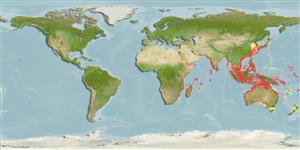Preferred temperature (Referencia
123201): 23.3 - 29.1, mean 28 °C (based on 1750 cells).
Phylogenetic diversity index (Referencia
82804): PD
50 = 1.0000 [Uniqueness, from 0.5 = low to 2.0 = high].
Bayesian length-weight: a=0.00977 (0.00466 - 0.02049), b=3.07 (2.90 - 3.24), in cm total length, based on LWR estimates for this (Sub)family-body shape (Ref.
93245).
Nivel trófico (Referencia
69278): 3.6 ±0.5 se; based on size and trophs of closest relatives
Resiliencia (Referencia
120179): Medio, población duplicada en un tiempo mínimo de 1.4-4.4 años (Preliminary K or Fecundity.).
Fishing Vulnerability (Ref.
59153): Low vulnerability (21 of 100).
🛈
Nutrients (Ref.
124155): Calcium = 62.8 [23.4, 219.9] mg/100g; Iron = 0.553 [0.235, 1.098] mg/100g; Protein = 18.3 [16.3, 20.3] %; Omega3 = 0.0737 [, ] g/100g; Selenium = 34.1 [16.8, 71.4] μg/100g; VitaminA = 69.8 [18.0, 275.8] μg/100g; Zinc = 1.15 [0.70, 1.68] mg/100g (wet weight);
